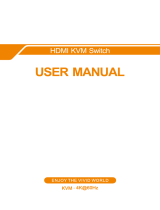
4
Safety Instructions
■ Readalloftheseinstructions.Savethemforfuturereference
■ Thisdeviceisforindooruseonly
■ Followallwarningsandinstructionsmarkedonthedevice
■ Donotplacethedeviceonanyunstablesurface(cart,stand,table,etc.).Ifthedevice
falls, serious damage will result
■ Donotusethedevicenearwater
■ Donotplacethedevicenear,orover,radiatorsorheatregisters
■ Thedevicecabinetisprovidedwithslotsandopeningstoallowforadequateventilation.
To ensure reliable operation, and to protect against overheating, these openings must
never be blocked or covered
■ Thedeviceshouldneverbeplacedonasoftsurface(bed,sofa,rug,etc.)asthiswill
block its ventilation openings. Likewise, the device should not be placed in a built in
enclosure unless adequate ventilation has been provided
■ Neverspillliquidofanykindonthedevice
■ Unplugthedevicefromthewalloutletbeforecleaning.Donotuseliquidoraerosol
cleaners. Use a damp cloth for cleaning
■ Thedeviceshouldbeoperatedfromthetypeofpowersourceindicatedonthemarking
label. If you are not sure of the type of power available, consult your dealer or local
power company
■ ThedeviceisdesignedforITpowerdistributionsystemswith230V
phase-to-phase voltage
■ Topreventdamagetoyourinstallation,itisimportantthatalldevicesare
properly grounded
■ Thedeviceisequippedwitha3-wiregroundingtypeplug.Thisisasafetyfeature.Ifyou
are unable to insert the plug into the outlet, contact your electrician to replace your
obsolete outlet. Do not attempt to defeat the purpose of the grounding-type plug. Always
follow your local/national wiring codes
■ Donotallowanythingtorestonthepowercordorcables.Routethepowercordand
cables so that they cannot be stepped on or tripped over
■ Ifanextensioncordisusedwiththisdevice,makesurethatthetotalAmpereratingsof
allproductsusedonthiscorddoesnotexceedtheextensioncordAmpererating.Make
surethatthetotalofallproductspluggedintothewalloutletdoesnotexceed
15 Amperes.
■ Tohelpprotectyoursystemfromsudden,transientincreasesanddecreasesinelectrical
power, use a surge suppressor, line conditioner, or un-interruptible power supply (UPS)
■ Positionsystemcablesandpowercablescarefully;Besurethatnothingrestson
any cable
■ Neverpushobjectsofanykindintoorthroughcabinetslots.Theymaytouchdangerous
voltagepointsorshortoutpartsresultinginariskofreorelectricalshock
■ Donotattempttoservicethedeviceyourself.Referallservicingtoqualied
service personnel
■ Ifthefollowingconditionsoccur,unplugthedevicefromthewalloutletandbring
ittoqualiedservicepersonnelforrepair
o The power cord or plug has become damaged or frayed
o Liquid has been spilled into the device
o Thedevicehasbeenexposedtorainorwater
o The device has been dropped, or the cabinet has been damaged




















